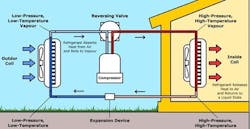Like pumping water uphill, heat pumps can "pump" heat from low-temperature environments to high-temperature environments. They don’t produce heat. They move it by circulating a working fluid, which "picks up" heat from a low-temperature media (air or water) that’s evaporated at a lower temperature and pressurized to release heat into a higher-temperature media.
This is how air conditioners work in the summer. They move heat from the cooler inside air of homes and release it into the warmer outside air. Similarly, a heat pump picks up heat from the cooler outside air and (after reversing the flow direction of the working fluid) releases it into the warmer inside air (Figure 1). Such bidirectional (split) heat pumps move heat in both directions because reversing the flow direction of the working fluid reverses the direction in which the heat is moved.
Operation
Traditionally split heat pumps are controlled in an on/off manner. The compressor is turned on at full capacity when one limit of the zero-energy band (ZEB) is reached, and turned off when the other is reached (Figure 2). The result is on/off cycling around the comfort setpoint because during operation the compressor discharge pressure is higher and the expansion valve burns more energy than needed.
A variable-speed heat pump, also known as the inverter-driven compressor, doesn’t operate at full speed. It operates only at the speed needed to meet the load. Instead of piston-type compressors, scroll compressors are used because they have longer lifespans and because heat pumps provide about 10 °F warmer air in heating mode.
The working fluid is often R-32, also known as HFC-32, which is an organic hydrofluorocarbon compound with the formula CH₂F₂. It’s a colorless, odorless, mildly flammable gas that’s insoluble in water.
Size and efficiency
Heat pumps provide heat more efficiently than electric strips. For example, at 10 °F outdoor temperature, typical heat pumps produce around 40% of their full capacity at twice the efficiency of electric strip heat. On colder days, when heat pump output is not enough to meet the heat requirement of a home, it must be supplemented by heat from a furnace or an electric strip as a backup. Figure 3 shows the type of relationship that might exist between the heating needs of a home and the amount of heat generated by a heat pump at different outdoor temperatures. Heat pumps are often sized for the two (pump capacity and home requirement) to be equal when the outdoor temperature is around freezing, also known as the balance point. Heat pumps can handle a minimum outdoor temperature of -15 °C (5 °F).
The capacity requirement is a function of the size of a structure and the climate zone where it’s located. For winter heating, a 1,500-sq-ft home in a hot climate requires a 45,000 BTU/hr unit. In cold climates, a 90,000 BTU/hr unit will be needed. The table included gives a rough estimate of the heating capacity requirements of these units in BTU/hr and as a function of the size of a structure. For purposes of comparison, the size range of typical residential gas furnaces is between 44,000 BTU/hr and 120,000 BTU/hr.
Optimized controls
These are the controls I’d use to operate a split heat pump serving the summer cooling and winter heating of a home or other, larger building. The system’s main controller is a multi-mode smart thermostat that manipulates the speed of a scroll compressor. This Wi-Fi-enabled, programmable split thermostat also controls the ZEB range and the operating modes of the system, which can be off (for maintenance or inside the ZEB range), cooling, heating, supplemental backup heating or defrosting. It also positions a four-way valve that sets the flow direction of the working fluid and the opening of its two-directional expansion valve, which closes when the compressor is off, and controls the superheat of the working fluid when it’s operating.
Ductless, mini-split heat pumps that serve individual rooms are more flexible and generally about 20% more efficient than centrally ducted ones. Their operating costs can be 40% less than electric heating. Individual, mini-split units control each room or “zone” separately. They eliminate wasted energy that occurs when some rooms are heated or cooled unnecessarily or excessively. Manual- or mobile phone-operated scheduling is one of the most powerful, smart thermostat features since it enables savings by smart thermostats.
Costs
Most state and local governments, as well as utility companies, keep expanding rebates and other incentives for homeowners who install heat pumps. In the U.S., the Dept. of Energy (DoE) supports heat pumps over traditional heating systems.
The cost of ducted, split heat pump systems is between $5,000 and $20,000, depending on heating/cooling capacities. The average installed cost is about $10,000, which is slightly higher than the cost of the same-sized gas furnaces. The cost range of ductless mini-split units is between $1,000 and $2,000.
Rebates and tax credits for heat pumps vary with location but are generally increasing. For example, the rebate provided by Massachusetts is around $10,000. The federal tax credit is 30% of costs, but limited to a maximum of $2,000.








